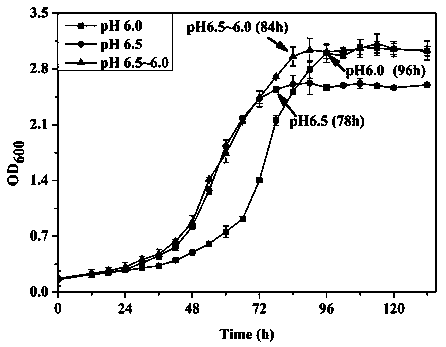A method for shortening the high-salt fermentation cycle of lactic acid bacteria by two-stage pH control
A fermentation cycle and lactic acid bacteria technology, applied in the field of microbial fermentation, can solve the problems of high osmotic pressure of fermentation liquid, prolongation of lag period of lactic acid bacteria, inhibition of physiological metabolism of lactic acid bacteria, etc., and achieve the effect of increasing the biomass of bacteria and shortening the fermentation time
- Summary
- Abstract
- Description
- Claims
- Application Information
AI Technical Summary
Problems solved by technology
Method used
Image
Examples
example 1
[0015] Example 1 (control group 1): Fermentation of tetradococcus halophilus CGMCC 3792 at a constant pH of 6.5 ( figure 1 )
[0016] (1) Seed culture: inoculate the seed culture medium with a 5% (v / v) inoculum of Tetradococcus halophilus glycerol tube stock solution stored at -80°C, and incubate at 30°C for 24 hours. The seed medium was (w / v): glucose 0.5%, soybean peptone 2%, magnesium sulfate heptahydrate 0.025%, ascorbic acid 0.05%, sodium chloride 0%, pH 6.5;
[0017] (2) Secondary seed expansion cultivation: take the above-mentioned activated seed solution, inoculate it into the expansion medium at an inoculation amount of 5% (v / v), and culture it at 30°C for 24 hours. Secondary seed medium is (w / v): glucose 0.5%, tryptone 0.5%, soybean peptone 0.5%, beef extract 0.5%, yeast extract 0.25%, magnesium sulfate heptahydrate 0.025%, ascorbic acid 0.05%, β-glycerol Sodium phosphate 1.9%, sodium chloride 6%, pH 6.5;
[0018] (3) Cultivate in 5 L fermenter; take the above-me...
example 2
[0019] Example 2 (control group 2): Fermentation of tetradococcus halophilus CGMCC 3792 at a constant pH of 6.0 ( figure 1 )
[0020] Other conditions are the same as example 1. Take the secondary seed culture liquid, inoculate 5% (v / v) inoculum in a 5 L fermenter for fermentation at 30°C, the liquid volume in the 5 L fermenter is 4 L, the stirring speed is 150 r / min, and the pH is controlled. is 6.0. After 96 hours of fermentation and cultivation, the stable period was reached, and the OD of the bacteria 600 The value is stable at 3.05.
example 3
[0021] Example 3 (experimental group): Fermentation of Tetradendococcus halophilus CGMCC 3792 under two-stage pH control conditions ( figure 1 )
[0022] Other conditions are the same as example 1. Take the secondary seed culture liquid, inoculate 5% (v / v) inoculum in a 5 L fermenter for fermentation at 30°C, the volume of the 5 L fermenter is 4 L, and the stirring speed is 150 r / min. The pH was controlled to be 6.5 for 60 hours, and the pH was controlled to be 6.0 after 60 hours. After 84 hours of fermentation, the stationary phase was reached, OD 600 The value is stable at 3.05. Compared with the constant pH 6.5 (control group 1), the bacterial biomass increased by 17.3%; compared with the constant pH 6.0 (control group 2), the time to enter the stable phase was shortened by 12 hours.
PUM
 Login to View More
Login to View More Abstract
Description
Claims
Application Information
 Login to View More
Login to View More - R&D
- Intellectual Property
- Life Sciences
- Materials
- Tech Scout
- Unparalleled Data Quality
- Higher Quality Content
- 60% Fewer Hallucinations
Browse by: Latest US Patents, China's latest patents, Technical Efficacy Thesaurus, Application Domain, Technology Topic, Popular Technical Reports.
© 2025 PatSnap. All rights reserved.Legal|Privacy policy|Modern Slavery Act Transparency Statement|Sitemap|About US| Contact US: help@patsnap.com

